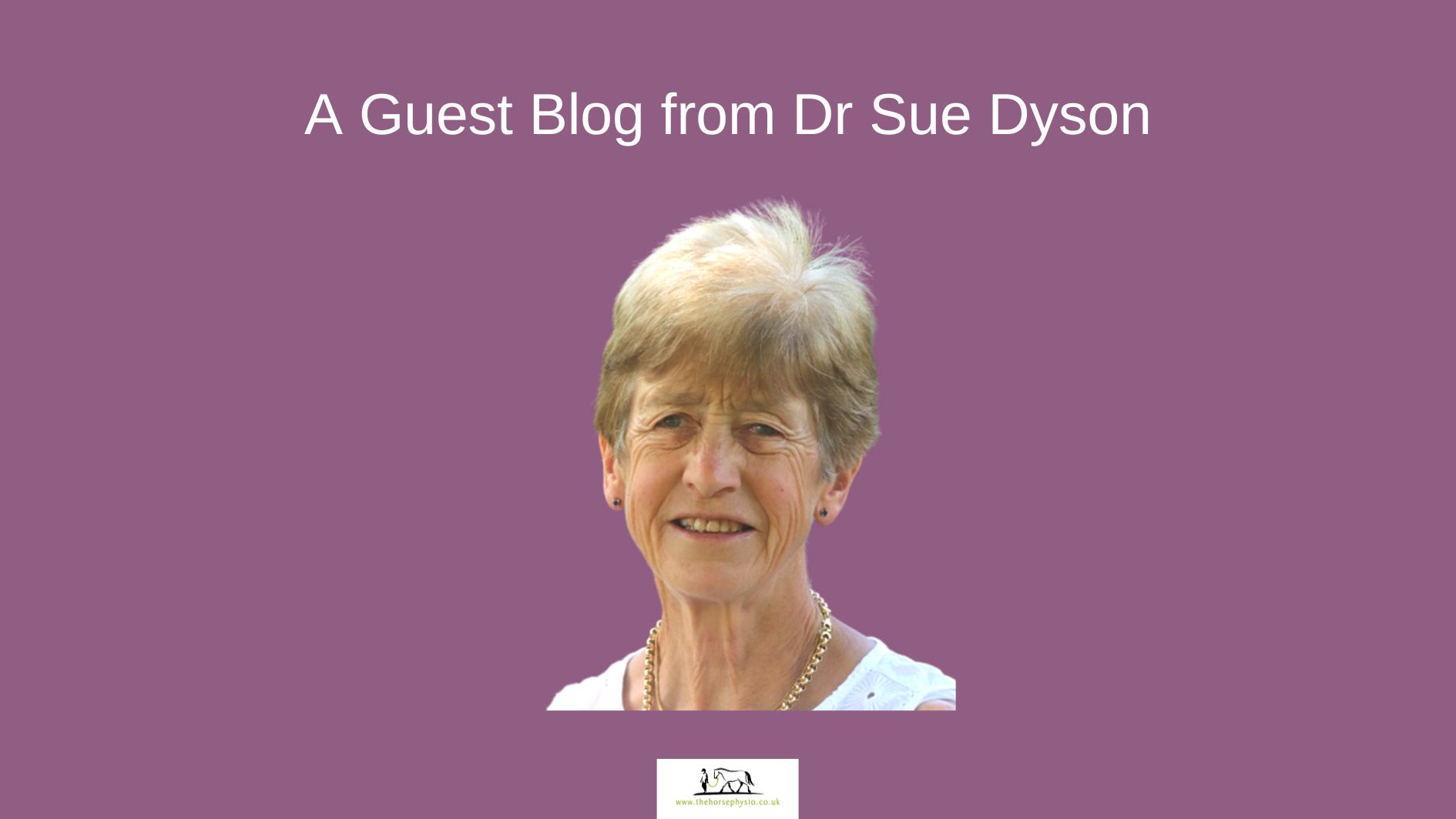If you prefer watching or listening, please click on the video above. If you like reading, please keep scrolling. Please note that this may contain affiliate links. Please subscribe to The Horse Physio newsletter, and follow, like and share me on the social media channels that you enjoy the most (you can find links to each channel at the bottom of this page). Your support is important to me and enables me to continue producing content to help you and your horse.
Bridle fit and the potential influence on performance: A Guest Blog by Dr Sue Dyson
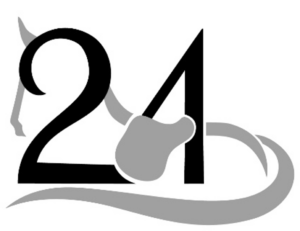
This blog was written by Dr. Sue Dyson and is read and shared by Sue Palmer. The book ‘Harmonious Horsemanship: Use of the Ridden Horse Ethogram to Optimise Potential, Partnership and Performance‘ is co-authored by Sue Dyson and Sue Palmer. ‘Harmonious Horsemanship’ has received rave reviews, including the Horse and Hound verdict: “If everyone involved with ridden horses, whether as a rider, trainer or carer, would read this book, the world would be a better place for horses in all situations.” Find out more about the authors and buy the book today by clicking here.
Bridle fit and the potential influence on performance
How much consideration have you given to the bridle which you use on your horse, why it was selected, how it is fitted and how it may influence your horse’s performance? Did you fit it or was the fit assessed by a professional fitter? I am the first to admit that earlier in my riding career I was pretty ignorant about the importance of optimal tack fit. I knew the somewhat arbitrary ‘two fingers’ rule for noseband tightness, ‘four fingers’ for the throatlash and how to assess the width of the bit and its position in the mouth. However, science has moved on and we now know through the use of modern technology that noseband and headpiece design and fit and the sites and magnitude of pressures created can influence symmetry of limb movement and quality of paces, presumably through enhanced comfort. In my opinion not all the studies published in the scientific literature stand up to scrutiny with respect to study design and interpretation of the results, nonetheless it is logical that a bridle which is stable in position and avoids major pressure points is preferable to one that does not. A horse’s head is sensitive; there are superficial nerves which are easily compressed, bones with little soft tissue protection, skin that will react to the presence of a fly, the tongue, the hyoid apparatus and the temporomandibular joints that have a close anatomical relationship with muscles involved with forelimb movement, and the sensitive tissues of the mouth.
I am not going to comment about the relative merits of different types of bridle design or the mechanism of action of different bits, but with reference to photographs I wanted to encourage people to think about bridle fit and how in some instances it might be improved.
It is important to recognise that one size does not fit all and the shape and relative proportions of different parts of a horse’s head vary considerably. A ‘so-called’ anatomical bridle will not have the curves and padding necessarily in the most appropriate positions for every horse. Moreover, the external dimensions of the head do not necessarily reflect the size of the oral cavity and the space available for the bit(s) and tongue.
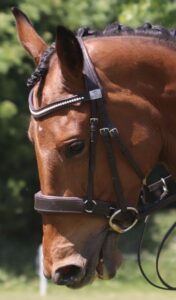
A wide padded crank cavesson noseband with a ring articulation with the cheekpiece of the noseband. This is positioned just below the facial crest, close to the nerves which provide innervation to the nose and lips, and which are potentially sensitive to pressure. The uniform padding of the front part of the noseband will distribute forces around the nasal bone. The contoured browband avoids pressure below the ears. The buckles of the cheek pieces are close to the temporomandibular joint. Why do bridle manufacturers make the cheek pieces so long?
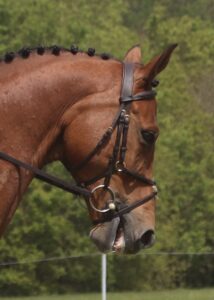
A well-fitted but obviously tight grackle noseband, with a small amount of padding under the front. The ring articulation of the upper part of the noseband with the cheekpiece is well behind the facial crest. The buckles of the cheekpieces are close to the temporomandibular joint. Note that a horse can still open its mouth despite a potentially restrictive noseband.
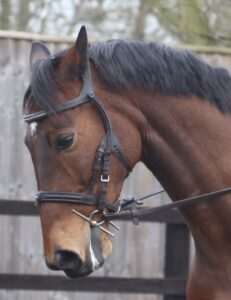
A contoured cheek piece presumably designed to avoid the temporomandibular joint, but the size and shape of the combined headpiece and browband makes the join with the cheekpiece close to the joint. The throatlash is tight. The slightly padded and relatively narrow cavesson noseband looks tight. The upper bar of the fulmer snaffle appears to press into the horse’s cheek.
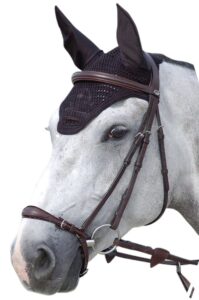
A drop noseband fitted low close to the junction between the nasal bones and the nasal cartilages. The ring between the front and back parts of the noseband is very close to the commissure of the mouth and the back strap overlaps the canon of the loose ring snaffle bit. The beaded part of the bonnet is compressed by the headpiece and browband.
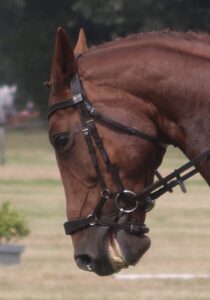
A wide, padded, double buckled drop noseband positioned at the junction of the nasal bones and the compressible nasal cartilages. The bulky junction between the headpiece, browband and tight throatlash is close to the temporomandibular joint.
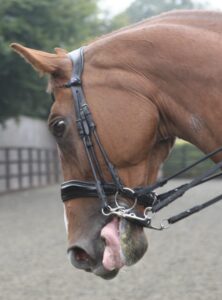
A well-fitted contoured headpiece and cheekpiece buckles well below the temporomandibular joint. A wide padded crank cavesson noseband spreading forces across the nasal bones and the rami of the mandibles. The angle of the curb bit of the double bridle is excessive. The tongue is clearly exposed.
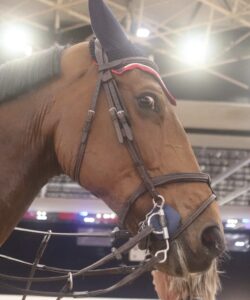
A narrow flash-type noseband with some padding over the nose but little over the rami of the mandibles. The flash part crossed over the bit guard. The throatlash looks tight. Even with loose reins the curb chain looks quite tight. The browband is close to the base of the ear and together with the headpieces compresses the edge of the bonnet. Bonnets have become very fashionable without necessarily always having a beneficial function.
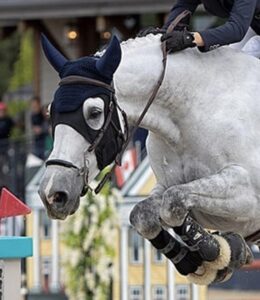
A hackamore bridle with a narrow nosepiece, with little padding, concentrating forces on the nasal bones and rami of the mandibles. In addition to a bonnet the horse is also wearing a titanium mask.
I believe that it is important to look holistically at a horse. If a horse is ‘fussy in the mouth’, creates increased rein tension on one rein of the bridle or ‘avoids’ a contact, has an unsteady head position or tilts the head it is important to be aware of all possible causes. These include the fit of the bridle, the bit and any influence of a martingale, oral lesions, sharp teeth edges, saddle fit and subclinical lameness. We also cannot forget the influence of the rider. Optimal comfort for the horse is likely to enhance performance.
This commentary is certainly not a fully comprehensive discussion of all aspects of bit and bridle fit but is written to promote thought and debate and to encourage improved standards.
This video, text and images are copyright Sue Dyson, 2023

Sue Dyson qualified as a veterinarian from the University of Cambridge in 1980. After an internship at the University of Pennsylvania and a year in private equine practice in Pennsylvania, Sue returned to Great Britain to the Animal Health Trust, Newmarket. Sue ran a clinical referral service for lameness and poor performance, attracting clients from all over the United Kingdom, Ireland and continental Europe for 37 years. From 2019 she has worked as an independent consultant, combining her horsemanship skills with her previous veterinary experience, with the aim of maximising performance potential.
Sue’s key interests are improving the diagnosis of lameness and poor performance and maximising the opportunity for horses to fulfil their athletic potential at whatever level, taking a holistic approach to the horse, rider and tack combination, and improving approaches to diagnosis and management. She has been involved not only in providing clinical services, but also clinically relevant research and education. Sue is co-editor, with Mike Ross, of Diagnosis and Management of Lameness in the Horse and co-author of Clinical Radiology of the Horse and Equine Scintigraphy. She has published more than 370 papers in peer reviewed journals concerning lameness and diagnostic imaging and has lectured worldwide to veterinarians, paraprofessionals, coaches, riders and judges.
Sue is a former President of the British Equine Veterinary Association and is currently scientific advisor to the Saddle Research Trust and Moorcroft Rehabilitation Centre. Sue is also a rider, and has produced horses from novice to top national level in both eventing and show jumping. Sue holds the Instructors and Stable Managers Certificates of the British Horse Society (BHSI).

Sue Palmer MCSP, aka The Horse Physio, is an award-winning author, educator, and Chartered Physiotherapist. Sue specialises in understanding the links between equine pain and behaviour, focusing on prevention, partnership and performance. She promotes the kind and fair treatment of horses through empathetic education, and is registered with the RAMP, the ACPAT, the IHA, the CSP and the HCPC.
To arrange a phone call or online coaching session with Sue Palmer, The Horse Physio, click here.
For news, views, and exclusive deals, please subscribe to our free newsletter. Your support is important to us, and helps us to continue to create content to help you and your horse.
You can find The Horse Physio on the web, on Facebook, on Instagram, and on YouTube, book an online consultation, or take a look at Sue’s online courses.

Horse Health Check: The 10-Point Plan for Physical Wellness
Head to Hoof: An Introduction to Horse Massage
Horse Massage for Horse Owners
Stretching Your Horse: A Guide to Keeping Your Equine Friend Happy and Healthy
Kissing Spines In Horses: Preventive Measures and Long-Term Management Solutions

Harmonious Horsemanship, co-authored with Dr Sue Dyson
Understanding Horse Performance: Brain, Pain or Training?
Horse Massage for Horse Owners

Thank you for your interest in this post; I appreciate your time and am grateful you chose to spend it with me. If you found value in this article, please support me by liking, subscribing, following, and sharing it on your favourite social media platform, and turn on the relevant notifications for future content from The Horse Physio. Please also take a moment to subscribe to my newsletter. Your support means the world to me, and it helps me continue creating content that matters to you.

